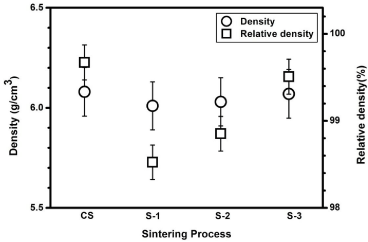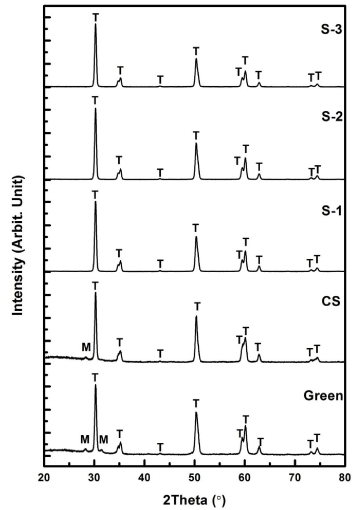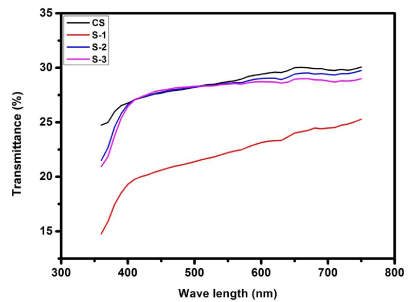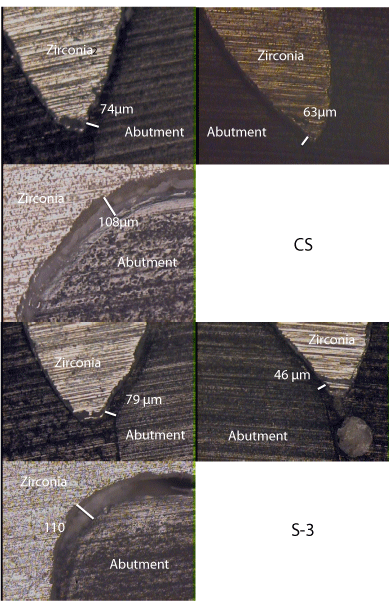
Research Article
Austin J Nutri Food Sci. 2018; 6(2): 1105.
Super-Speed Sintered Dental Zirconia for Chair-Side One-Visit Application
Ling Li¹, Yuexiu Qiu² and Wenjie Si³*
¹Department of Stomatology, Beijing JiShuiTan Hospital, China
²Shenzhen Upcera Co., Ltd, China
³State Key Laboratory of New Ceramics and Fine Processing, Tsinghua University, China
*Corresponding author: Wenjie Si, State Key Laboratory of New Ceramics and Fine Processing, Tsinghua University, Beijing 100084, China
Received: April 12, 2018; Accepted: May 08, 2018; Published: May 16, 2018
Abstract
Objective: To satisfy the requirement of dental chair-side clinical technique, zirconia ceramics is required to be sintered in less than one hour; the effect of super-speed sintering dwelling time on dental zirconia’s micro-structure, mechanical properties and the marginal and internal adaptation of zirconia crown were investigated in this work.
Methods: Zirconia specimens were sintered through super-speed sintering furnace. The relative density was measured by the Archimedes method. Scanning electron microscopy and X-ray diffract meter were employed to characterize the microstructures. Universal mechanical test machine and Vickers indenter were used to evaluate the mechanical properties. Spectrophotometer was utilized to analyze the optical transmittance, and optical microscope was used to estimate the marginal adaptation of zirconia crown with abutment.
Results: Dwelled at 1580°C for 20 min, the dental zirconia ceramic obtainsa bending strength of around 1151 MPa, a hardness of 13.3 GPaanda fracture toughness of 5.92MPa•m1/2,respectively, as well as adaptable optical transmittance and marginal adaptation.
Conclusion: Dental zirconia ceramics can be super-speed sintered. Dwelled at 1580°C for 20 min, dental zirconia can achieve adaptable clinical performances.
Keywords: Dental zirconia, super-speed sintering, chair-side, mechanical properties
Introduction
With the development of Computer Aided Design and Computer Aided Manufacture (CAD/CAM) technologies for dental applications, clinicians can complete adental prosthesis at the “chair-side” in a single patient visit. Chair-side CAD/CAM dental techniques eliminate the laboratory processing and the requirement for reduplicate-visit temporization of the prepared tooth structure, which highly increases dental treatment efficiency and saves patient’s costs [1].
Zirconia dental ceramic has excellent mechanical properties, biocompatibility, and fabrication simplicity, which is a well-established biomaterial used in dentistry [2]. Traditionally, the sintering of dental zirconia for engineering applications is a time consuming process, which involves a “slow” heating and cooling rate (typically 2 –10 °C per minute) coupled with a prolonged dwell time (often amounting to several hours); thus, hinders the zirconia ceramics for chair-side clinical treatment. To overcome the limitation, the effect of speed sintering on the dental zirconia has been investigated, results showing that the dental zirconia can be densified after a dwell time of dozens of minutes at around 1540 °C [3]. The series of research efforts bring about the dental zirconia novel super-speed sintering technique. The dental zirconia can be densified after a dwell time of 25 min at around 1540 °C [4] with fracture strength of around 622.3 ± 82.7 MPa. Now, several commercially super-speed sintering furnaces are already in the market, such as “in Fire HTC speed” (Sirona, Germany) and “zirconia super-speed sintering furnace” (KEJIA, China). Although, speed and super-speed sintered dental zirconia are already applied in dental clinic, seldom has yet been published on the effect of dwelling temperature and time of monolithic dental zirconia restorations, let alone the reason why super-speed sintering could densify zirconia dental ceramic.
In this work, dental zirconia ceramics are sintered through super-speed sintering technique; the effect of sintering temperature and dwelling time on dental zirconia’s micro-structure, mechanical properties and the marginal and internal adaptation of zirconia crown are discussed. It is found thatdwelled at 1580°C for 20 min, the dental zirconia ceramic can achieve adaptable clinical property with bending strength of around 1151 MPa.
Material and Methods
Zirconia dental blocks with 3 mol. % Y2O3 (ST-3Y-TZPA2 preshaded Zirconia Blank, UPCERA, China) were used for all experiments. The zirconia samples and crowns tested herein were CAD/CAM-milled, sintered by a super-speed zirconia sintering furnace (KEJIA, China). Sintering was carried out according to the following processes: Conventional sintering (CS, reference group): heating at 2 °C/min to 1480 °C, then dwelling for 120 min, followed by cooling at 30 °C/min down to 200 °C before removing from the furnace. Total sintering time is around 15 h.
Super-speed sintering-1 (S-1): heating at 400 °C/min to 1200 °C, then at 190 °C/min to 1580 °C, dwelling for 2 min, followed by cooling at 310 °C/ min down to room temperature before removing from the furnace. Total sintering time is 12 min.
Super-speed sintering-2 (S-2): heating at 400 °C/min to 1200 °C, dwelling for 5 min, then at 190 °C/min to 1580 °C, dwelling for 10 min, followed by cooling at 310 °C/ min down to room temperature before removing from the furnace. Total sintering time is 25 min.
Super-speed sintering-3 (S-3): heating at 400 °C/min to 1200 °C, dwelling for 10 min, then at 190 °C/min to 1580 °C, dwelling for 20 min, followed by cooling at 310 °C/ min down to room temperature before removing from the furnace. Total sintering time is 40 min.
The relative density was measured by the Archimedes method from 3 samples of each experimental condition and estimated by using the theoretical density of 6.10 g/cm3 for3Y-TZP ZrO2 [5].
The cross-sectional microstructure was investigated using Field Emission Scanning Electron Microscopy (FE-SEM, JEOL JSM-6701F, and Japan). For micro structural analyses, all the zirconia specimens were thermally etched prior to SEM examination. To prevent any grain growth, the zirconia specimens were thermally etched at 1150 °C for 1h with a heating and cool rate of 40 °C/min. The zirconia grain size was measured by image analysis on surfaces using the linear intercept method [6].
The phase composition was identified on a D8 advance XRD system (Cu Ka radiation, ?=0.15406 nm; Bruker, Germany), operating at40 kV and 40 mA between 20° and 80° (2?). The relative amount of monoclinic and tetragonal phase percentages were determined from the correlation by Toraya [7].
The flexural strength was determined by three-point bending method on a WDW-100 versatile mechanical test machine (KQL Testing Instruments Co., Ltd., China) applying a crosshead speed of 0.5 mm/min. Ten samples for each group were cut and polished to rectangular dimensions of 20mm×4mm×1.2mm, and an average value of flexural strength was calculated. The hardness and fracture toughness (KIC) values were obtained from the indentation fracture method [8]. The Vickers indenter indented the test specimens with a loading weight of 294 N for 15 seconds to produce indentation and cracking, lengths were measured. One indentation was made on each test piece. The Vickers hardness (HV) was calculated through the following formula defined by ISO 6507-1:
HV=0.1891F/(2a)2(1)
Where, F is the loading weight (N), and 2a is the length of the indentation (mm). The fracture toughness value (MPa·m1/2) was calculated through Nihara formula [9]:
KIC = 0.203(c/a)-3/2Ha1/2(2)
Where, KIC is the fracture toughness value (MPa·m1/2), a is the ½ length of the indentation (μm), c is the 1/2 length of the crack (μm), and H is the Vickers hardness (HV). The results were analyzed by the one-factor analysis of variance (ANOVA), followed by least significant difference (LSD) t-test (a=0.05, SPSS 20.0). The significance level was set at P < 0.05.
The optical transmittance of zirconia specimen was analyzed through a spectrophotometer (Color i7800, Xrite, America), which was conducted within the visible spectrum from 300 to 800 nm.
Optical microscope was used to evaluate marginal and internal adaptation from average values of different cuts in the buccolingual and mesiodistal direction and the average internal space of zirconia artificial crown prepared through conventional and superspeedsintering- 3 technique. The abutment and full crown are designed via Dental Designer (3Shape, Danmark). After each abutment and crown was designed, the information was sent to the milling unit (Roland 51D, Japan). The complete crowns were fabricated with zirconia dental blocks, and the abutments were fabricated with Polymethyl methacrylate blocks. Each crown was cemented with glass ionomercement to its corresponding abutment and held in place for 10 misusing universal testing machine which applies a 5 kg static load. And then, the specimen was cut with a diamond saw. The Longitudinal-section of each specimen was photographed using Digital optical microscope with a built-in camera connected with a compatible personal computer using a fixed magnification of 40×. A digital image analysis system was used to measure and qualitatively evaluate the discrepancy width.
Results and Discussion
Figure 1 shows the relative density of dental zirconia with different densifying processes, conventional sintering and superspeed sintering. The density of zirconia with CS process is around 6.08 g/cm3 which are 99.67% of the theoretical density. Those of super-speed sintered zirconia are 6.01, 6.03, and 6.07 g/cm3 for S-1 to S-3, respectively. Compared with theoretical density of 6.10 g/cm3, all these zirconia specimens are densified with the lowest relative density of around 98.52% for S-1. According to the isothermal sinteringmodel [10]: where a is the radius of the solid particles, (?L/L0) is the relative shrinkage, F(T) is the function depending on the temperature and materials parameters, n and m are constants typical for each individual mass transport mechanism, and t is the holding time. The shrinkage is proportional to sintering temperature and dwelling time. Improving sintering temperature from 1480 °C to 1580 °C, and depressing the dwelling time from 2 h to 20, 10 or 2 min, dental zirconia were all densified and achieved similar relative shrinkage; meanwhile, zirconia sintered with longer dwelling time purchases higher relative density.

Figure 1: Density and relative density of dental zirconia.
Figure 2 presents the XRD pattern of zirconia before and after sintering. The monoclinic and tetragonal phases are presented in the green body and conventional sintered zirconia; the amounts of monoclinic phases are around 10 % and 5%, respectively. For the other three super-speed sintered zirconia specimens, there is no obviously monoclinic phase. Compared with conventional long time sintering, short dwelling time helps zirconia to keep tetragonal phase.

Figure 2: XRD pattern of zirconia before and after sintering.
Figure 3 shows cross-sectional morphologies of the sintered four zirconia test groups. All the zirconia specimens have a dense microstructure. For grain size measurements, the bigger grain boundaries were considered when counting the linear intercepts. The grain sizes of sintered zirconia are tabulated in Table 1. The grain size of conventional sintered zirconia is around 0.63 μm, those of superspeed sintered zirconia are 0.32, 0.51 and 0.59μm for S-1, S-2 and S-3. This result indicates that longer dwell time promotes grain growth.

Figure 3: Cross-sectional morphologies of the sintered zirconia.
CS
S-1
S-2
S-3
Grain size (μm)
0.63
0.32
0.51
0.59
Flexural strength (MPa)
1172(73)
1038(183)
1087 (124)
1151(149)
Hardness (GPa)
13.4(0.2)
13.6(0.2)
13.4(0.3)
13.3(0.1)
Fracture toughness (MPa·m1/2)
5.89(0.18)
5.33 (0.34)
5.49(0.17)
5.92(0.09)
Table 1: Grain sizes and mechanical properties of dental zirconia.
Mechanical properties are the key performances for dental ceramics to guarantee the long-term clinical efficacy. The flexural strength, hardness and fracture toughness of zirconia specimens sintered with different process are tabulated in Table 1. In present study, the flexural strength of zirconia with conventional sintering process is around 1172 MPa, the hardness is around 13.4 GPa, and the fracture toughness is around 5.89 MPa·m1/2. For super-speed sintered zirconia, the flexural strengths are 1038, 1087 and 1151 MPa, respectively, for S-1, S-2 and S-3 samples. The hardness is 13.6, 13.4 and 13.3 GPa; and, the fracture toughness is 5.33, 5.49 and 5.92MPa·m1/2, respectively. For super-speed sintering dental zirconia, as function of holding time at maximum temperature, it seems longer dwelling time results in higher flexural strength.
Figure 4 depicts the optical transmittance of zirconia sintered with different process. Transmittance is one of the main parameters in matching the appearance of the natural tooth and was identified as pivotal factor in controlling aesthetics [11]. From Figure 4, conventional sintered zirconia, and super-speed sintered-2, -3, whose maximum temperature dwelling time is 10 and 20 min have similar optical transmittance. The optical transmittance for S-1, which dwelled at 1580 °C for only 2 minutes, is lower than the others. The residual pore is adverse for optical transmittance, which has different refractive index with zirconia; when visible light passes through the interface between pore and grain, part of the lights are scattered. The relative density of S-1 is around 98.52%, which means there are more residual pores in S-1; thus, S-1 specimen has lowest optical transmittance. For super-speed sintered zirconia, with dwelling time increasing, the specimen has higher relative density as well as the higher optical transmittance.

Figure 4: Optical transmittance of the sintered zirconia.
Direct viewing technique is a rapid, easy and convenient method, which has been most frequently used to measure the marginal adaptation. Figure 5 shows the discrepancy between sintered zirconia and abutment. Because the restoration needs a lusting cement film of 20- 40 μm thickness [12], thus, the marginal discrepancy of 120 μm should be the limit of clinical acceptability [13]. The vertical discrepancy of conventional sintered zirconia is around 108 μm, and the marginal discrepancies in the facial and lingual surfaces are 74 and 64 μm, respectively. The value for super-speed sintered-3 zirconia is similar with conventional sintered zirconia. The vertical discrepancy of S-3 is around 110μm, and the marginal discrepancies in the facial and lingual surfaces are 79 and 46 μm, respectively. These data means the super-speed sintered zirconia has a similar marginal adaptation with conventional sintered zirconia.

Figure 5: Discrepancy between sintered zirconia crown and abutment.
Conclusion
Within the limitation of this in-vitro study, the following conclusions could be drawn: Dental zirconia ceramics can be superspeed sintered at 1580°C with dwelling time less than 20 min to achieve adaptable clinical performances which are feasible for chairside one-visit application. In 20 minutes, longer dwelling time can improve the transmittance and mechanical properties of dental zirconia. Dwelled at 1580°C for 20 min, the dental zirconia ceramic obtains a bending strength of around 1151 MPa, a hardness of 13.3 GPa, and, a fracture toughness of 5.92MPa·m1/2, respectively.
References
- Addison O, Cao X, Sunnar P, Fleming GJ. Machining variability impacts on the strength of a ‘chair-side’ CAD–CAM ceramic. Dent Mater. 2012; 28: 880-887.
- TA Sulaiman, AA Abdulmajeed, TE Donovan, LF Cooper, R Walter. Fracturerate of monolithic zirconia restorations up to 5 years: a dental laboratory survey. J Prosthet Dent. 2016; 116: 436-439.
- NM Ersoy, HM Aydogdu, BÜ Degirmenci, N Çökük, M Sevimay. The effects of sintering temperature and duration on the flexural strength and grain size of zirconia. Acta Biomater Odontol Scand. 2015; 1: 43–50.
- MR Kaizer, PC Gierthmuehlen, MBF dos Santos, SS Cava, Y Zhang. Speed sintering translucent zirconia for chairside one-visit dental restorations: Optical, mechanical, and wear characteristics, Ceram. Int. 2017; 43: 10999–11005.
- Camposilvan E, Marro FG, Mestra A, Anglada M. Enhanced reliability of yttria-stabilized zirconia for dental applications. Acta Biomater. 2015; 17: 36-46.
- JC Wurst, JA Nelson. Lineal intercept technique for measuring grain size in twophase polycrystalline ceramics. J Am Ceram Soc. 1972; 55: 109.
- H Toraya, M Yoshimura, S Somiya. Calibration curve for quantitative analysisof the monoclinic-tetragonal ZrO2 system by x-ray diffraction. J Am Ceram Soc. 1984; 67: C119-C121.
- K Harada, A Shinya, H Gomi, Y Hatano, A Shinya, AJ Raigrodski. Effect of accelerated aging on the fracture toughnessof zirconias. J. Prosthet. Dent. 2016; 115: 215-223.
- K Niihara, A Nakahira, T Hirai. The effect of stoichiometry on mechanical properties of boron carbide. J Mater Sci let. 1984; 67: C13–C14.
- RM German. Powder Metallurgy Science, 2nd edition, Princeton MPIF, NJ. 1994.
- Miyagawa Y, Powers JM, O’Brien WJ. Optical properties of direct restorative materials. J Dent Res. 1981; 60: 890–894.
- E Hilgert, MP Neisser, MA Bottino. Evaluation of the marginal adaptation of ceramic copings in function of the cervical endings and treatment of the internal surfaces. Clin Odontol Bras. 2003; 6: 9-16.
- Mclean JW, Von Fraunhofer JA. The estimation of cement film thickness by an in vivo technique. Br Dent J. 1971; 131: 107-111.